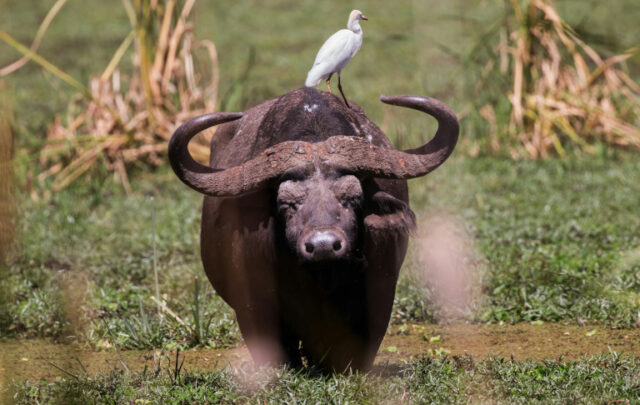In the early 1970s, a wild species of grass saved its cousin, rice, from the devastating grassy stunt virus. Today, a global partnership managed by The Crop Trust and the Millennium Seedbank at Kew is scaling up a ten-year effort to catalog, conserve, and prepare the genetics of other wild cousins of major crops, known as crop wild relatives(CWRs), in light of increasing stresses to agriculture including climate change and population growth.
The total damage from the rice virus amounted to more than US$2.5 billion in 2017 dollars and at least 116,000 hectares (287,000 acres) of destroyed rice fields before it was stopped, according to the International Rice Research Institute (IRRI). Scientists at IRRI reacted to the outbreak by screening nearly 7,000 varieties of modern rice and rice CWRs for resistance to the virus. They found only one that was resistant: a sample of Oryza nivara, a rice CWR that is native to Uttar Pradesh, India. By 1988, IRRI reported that more than 30 million hectares (74 million acres) in 30 countries were planted with varieties of virus-resistant rice bred to contain genes from Oryza nivara.
In contrast, scientists in the 1840s did not yet know that potato CWRs contain genes for resistance to the disease that triggered the Irish Potato Famine, and so could not respond in time to save the 1 million Irish who died from starvation and related causes.
Estimates of the economic value of crop wild relatives vary widely, but the business services firm PricewaterhouseCoopers put the total potential value of the future use of wild genepools of 32 major global crops at up to US$196 billion. Meanwhile, more than one-fifth of plant species worldwide are threatened with extinction due to increasing pressure from wars, pollution, urbanization, climate change, the intensification of agriculture, and invasive species, according to the Royal Botanic Gardens, Kew.
“It’s now clear that scientists around the world are in a race against time to collect and conserve many of the most important plant species for future food security,” says Dr. Nora Castañeda-Álvarez, a scientist at The Crop Trust.
The Crop Trust, the Millennium Seed Bank at Kew, and their partners are confronting this problem on a global level by identifying gaps in the world’s collections of CWRs, supporting the collecting efforts of 24 national programs to fill those gaps, and working with more than 40 institutions to develop pre-breeding materials that will help adapt crops to a changing climate.
Castañeda-Álvarez was part of an international team that published a study in 2016 showing that 95 percent of CWRs are insufficiently represented in the world’s genebanks. Genebanks are collections of samples of crops and CWRs around the world designed to make genetic resources available cheaply and effectively for the long term. Crops for which CWRs are in “urgent need of collection and conservation” include banana, sweet potato, carrot, pineapple, and spinach. Even collections for CWRs of some vital staples like rice, wheat, potato, and maize show “significant gaps.” The team found that 29 percent of the CWRs for 81 of the world’s most important crops are completely missing from the world’s genebanks.
Because CWR genetic material has value to agricultural systems around the world, the members of the CWR partnership ensure the availability of the collected and developed materials under the terms of the International Treaty on Plant Genetic Resources for Food and Agriculture to ensure international access. Breeders and farmers around the world can obtain and work with materials stewarded in any of the 144 countries that are party to the Treaty as long as they agree to make varieties they develop freely available or, if they develop a commercial product, pay a percentage of profits into a benefit-sharing fund.
Luis Salazar, The Crop Trust’s Communications Manager, explains,
“We live in an interdependent world. We all eat the same basic staple crops, and thus it’s everybody’s responsibility to also make sure we safeguard the crop diversity that is the basis of our food security.”
In order to make the resilience traits that CWRs may display available for breeders to work with, the CWR partnership has initiated pre-breeding projects focused on 19 high-priority crops. The pre-breeding process aims to isolate desired genetic traits and introduce them into breeding lines that are more readily crossable with modern varieties.
Lentils were chosen for pre-breeding because they fix their own nitrogen and are the main source of protein in many diets that are low in meat but face an “extreme” genetic bottleneck and are suffering from droughts and fungus in production centers like Turkey and Canada. Carrots are a vitamin-rich, storable, high-value crop that is seeing significant yield gaps in high-stress growing conditions, such as saline soils in Bangladesh and more regular heat waves in Pakistan. Sweet potato plants grow fast, need little input and labor, produce more energy per land area than any other food crop, and have served as a vital famine relief crop in countries from Mozambique to Japan.
As climate change and other pressures continue to increase in severity, the value of the CWR project’s work will only become more urgent, according to Marie Haga, the Executive Director of The Crop Trust. She recently told Food Tank,
“The astonishing range of species and varieties cultivated by farmers past and present is one of the world’s most valuable natural resources. It represents the raw materials that plant breeders and farmers need for tomorrow’s climate-resilient crops. When we lose this diversity, we lose our options for the future.”
For example, the sub-group of banana varieties that makes up 99 percent of banana exports derives from one variety grown by one man in the 1950s that proved resistant to a fungus that nearly wiped out the global banana market. Today, multiple new fungal pathogens are spreading through banana plantations around the world with even greater speed because of the efficiency of international transportation and increasingly variable precipitation patterns caused by climate change. The banana is the world’s most popular fruit, according to the United Nations Food and Agriculture Organization. In the quest to save it, The Crop Trust and its partners are turning to banana CWRS for answers.





